
Hoi An travel guide: Discovering the ancient Chinese assembly halls
These places not only preserve historical values but also attract visitors with their impressive architecture and peaceful atmosphere. If you're looking for fresh experiences on your journey to explore and gain insights into Hoi An tourism, make sure to take time to visit the 5 famous Chinese assembly halls introduced below!
1. Hoi An: The ancient beauty and unique cultural fusion
Hội An is not only charming for its ancient beauty but also for its distinctive cultural fusion. Once a bustling trading port since the 16th century, this town was a meeting point for merchant ships from all over the world. As a result, Hoi An retains cultural imprints from many countries, from China and Japan to Western nations.
However, Hoi An is not just a museum preserving the past but also a living ancient town, vibrant with the bustling life of the local people. Strolling along its small streets, visitors may encounter images of artisans working diligently, street vendors weaving through alleys, or small eateries along the road exuding irresistible aromas. Hoi An's cuisine is a harmonious blend of Vietnamese and Chinese culinary cultures, creating unique dishes that carry a distinct signature.
In addition to traditional Vietnamese dishes like mì Quảng, cơm hến (clam rice), bánh đập (crispy rice paper), bánh vạc (white rose dumplings), bánh xèo (Vietnamese pancakes), visitors also have the opportunity to enjoy many delicious Chinese-influenced dishes, skillfully and delicately prepared by local people. These culinary experiences are often highlighted in any Hoi An travel guide for those exploring the town's rich food culture.
>> See more: Enrich the list of 15 must-try restaurants for authentic Hoi An food
The people of Hoi An are gentle, friendly, and hospitable. They always greet visitors with bright smiles, welcoming them to their hometown. They take pride in preserving and protecting their cultural heritage, which they regard as a source of pride for their homeland.
Hoi An has been recognized by UNESCO as a World Cultural Heritage Site and is a popular destination for tourists from around the world. It has been honored with numerous prestigious awards such as "Asia's Leading Cultural City Destination," "Top 25 Best Travel Cities in the World," "Top 21 Most Romantic Destinations in the World," "Top 10 Most Hospitable Cities in the World," and more.
>> See more: Hoi An Ancient Town and 1001 things you might not know
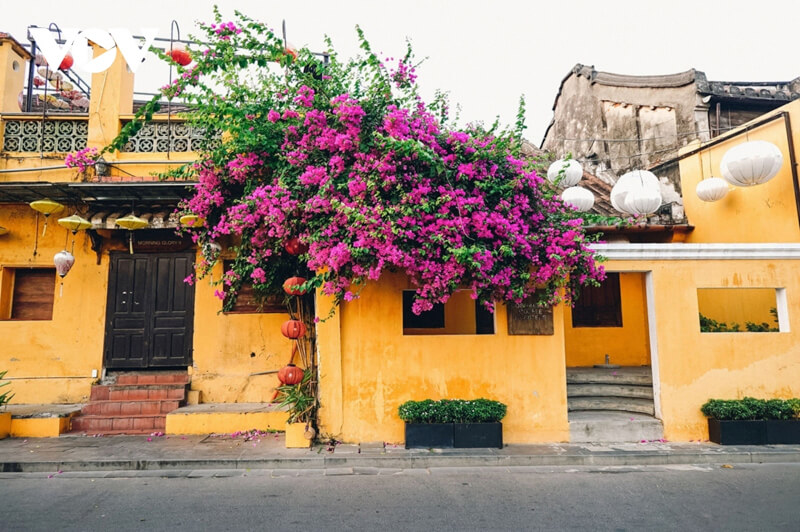
Hoi An travel guide for tourists is to learn about the ancient history of this heritage region
2.The assembly halls: Unique architectural works bearing strong Chinese cultural imprints
“Lối này ngõ phố rêu phong
Nhà cổ cột lim nhẵn bóng
Lối kia hoa văn Hội Quán
Đến rồi đâu dễ dời đi..."
"This path through moss-covered streets,
Ancient houses with polished lim columns,
That path leads to the Assembly Hall's intricate carvings,
Once arrived, hard to part and leave..."
Along the ancient streets of Hoi An, visitors are not only impressed by the moss-covered rooftops and the golden-hued walls but also by the unique architectural works heavily influenced by Chinese culture – the Chinese assembly halls, which are a must-see in any Hoi An travel guide.
The assembly halls are not just community gathering places for the Chinese diaspora but also locations that preserve their cultural identity, beliefs, and traditions. These places serve as spiritual destinations that attract tourists with their historical value and distinctive architecture.
The assembly halls were built based on the solidarity of Chinese people who shared the same hometown or profession. These were places where they met, shared business experiences, supported each other in life, and preserved traditional cultural values.
The architecture of the assembly halls is deeply influenced by Chinese culture, featuring curved roofs, intricate patterns, and vibrant colors. However, the assembly halls in Hoi An also exhibit a fusion with Vietnamese architecture through elements such as yin-yang tiled roofs, gracefully curved ridge tiles, and murals depicting everyday life scenes.
Additionally, the assembly halls stand as testimony to Hoi An's bustling trade history in the past. They house many precious artifacts such as statues of deities, worship items, and stone steles, contributing to the richness of Hoi An’s cultural heritage. Furthermore, the assembly halls are places of worship for various deities, according to the folk beliefs of the Chinese. Visitors can come here to pray for peace and good fortune for themselves and their families.
See more: Lost in the fairy tale world with these beautiful streets in Hoi An
3. 5 Chinese Assembly halls in Hoi An with impressive architectural styles
3.1 Phúc Kiến Assembly Hall
- Address: 46 Trần Phú Street, Hoi An, Quảng Nam
- Opening hours: 7:00 AM - 5:00 PM daily
- Ticket prices for Phúc Kiến Assembly Hall: 150,000 VND (about $6.10 USD) for foreign guests
With a total architectural area of 2,000 square meters, a depth of 100 meters, and a width of 24 meters, the Phúc Kiến Assembly Hall was built in the "tứ hợp viện" style, also known as "seal-shaped," symbolizing grandeur and solemnity. The overall layout is arranged in an orderly manner from front to back, consisting of:
- Tiền môn (Front gate): The main entrance leading to the assembly hall’s courtyard, where visitors begin their journey of discovering the unique architectural beauty here.
- Sân trước (Front courtyard): A spacious and airy space, creating a peaceful and calm atmosphere before stepping into the main area of the assembly hall.
- Tam quan (Triple gate): The three gates represent the Three Realms – Heaven, Earth, and Humanity, a place where visitors can purify their souls before entering the main sanctuary.
- Sân trước tiền điện (Front courtyard of the antechamber): The area leading to the antechamber, where the solemn statue of Guan Yu stands, symbolizing loyalty and righteousness.
- Tiền điện (Antechamber): A place of worship for Guan Yu, with finely carved statues, showcasing the reverence and admiration of the people for this heroic figure.
- Sân thiên tĩnh (Quiet courtyard): A peaceful space between the antechamber and the main sanctuary, offering a sense of tranquility and peace to the soul.
- Chính điện (Main sanctuary): A place of worship for the Heavenly Empress (Thiên Hậu Thánh Mẫu), the deity who protects merchants as they brave the ocean waves.
- Sân thiên tĩnh (Peaceful Courtyard): A serene space between the main sanctuary (Chính Điện) and the rear sanctuary (Hậu Điện), where visitors can pray for peace and good fortune for themselves and their families.
- Hai dãy nhà Đông và Tây (East and West Wings): These wings house subsidiary altars dedicated to other deities and serve as community gathering spaces for the Chinese in Hoi An.
The main architecture of Quảng Đông Assembly Hall is arranged in the shape of the Chinese character “三” (San), with the antechamber, main sanctuary, and rear sanctuary aligned in parallel, symbolizing balance and harmony. This is a characteristic layout of Chinese temples, spread over a large area.
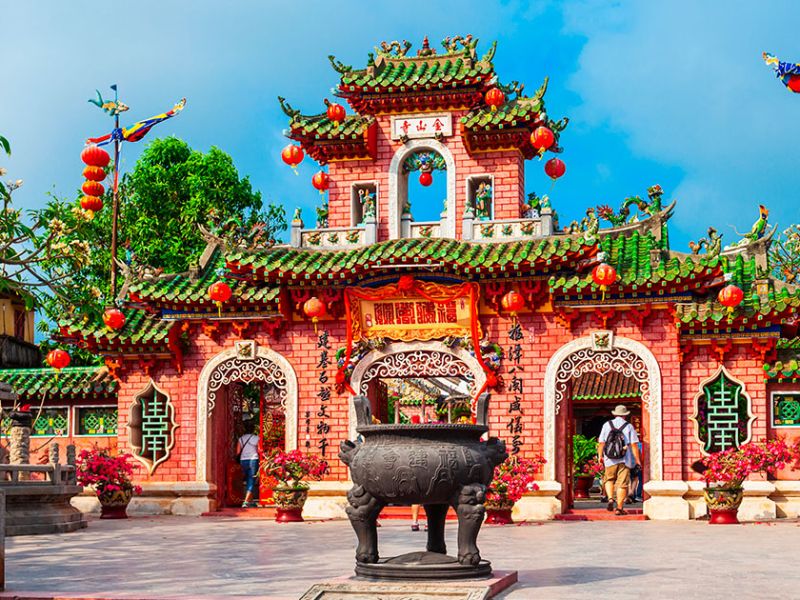
The Phúc Kiến Assembly Hall features a characteristic layout typical of Chinese temples.
3.2 Quảng Đông Assembly Hall
- Address: 176 Trần Phú Street, Hội An, Quảng Nam Province
- Opening Hours: 6:00 AM - 4:00 PM daily
- Ticket Prices: 150,000 VND (about $6.10 USD) for foreign guests
The Quảng Đông Assembly Hall was constructed in 1885 by a Chinese merchant during the 18th century. Initially, it was dedicated to Confucius and the Heavenly Empress (Thiên Hậu Thánh Mẫu). After 1911, the hall was converted to honor the Forebears (Tiền Hiền) and Guan Yu (Quan Công). The assembly hall played an important role in the spiritual and communal life of the Chinese in Hội An, serving as a place for worship, as well as for seeking blessings and good fortune in business. It was also a gathering place for the local Chinese community to offer mutual support in both life and work, and it's often featured in a Hoi An travel guide for visitors exploring the town’s rich heritage.
The Quảng Đông Assembly Hall is notable for its harmonious architectural combination of wood and stone. Intricate and delicate carvings adorn the structure, showcasing deep Chinese cultural imprints. The hall is built in a closed layout in the shape of the character "Quốc" (國), on a high, spacious plot of land, and includes the following features:
- Triple Gate (Cổng Tam Quan): Upon entering, visitors are greeted by three large murals depicting three famous generals from the Three Kingdoms era: Liu Bei, Zhang Fei, and Guan Yu.
- Antechamber (Nhà Tiền Điện): This large structure features intricately carved stone walls, multi-tiered high roofs, and relief carvings inspired by ancient stories.
- Courtyard (Khuôn viên): A spacious garden courtyard with carefully tended bonsai trees. At the center lies a large pond where visitors can admire the image of a dragon carved based on the legend of "Lý Ngư Hóa Long" (The Carp Transformed into a Dragon).
- Main Sanctuary (Chính Điện): A vast space characterized by massive supporting columns, divided into three sections. The central section is dedicated to Guan Yu, while the side sections honor the God of Fortune (Phước Đức Chánh Thần) and the Star of Wealth (Tài Bạch Tinh Quân).
- East and West Wings (Tả Vu, Hữu Vu): These two buildings connect the antechamber to the main sanctuary and are designed with simple architecture.
- Guest Reception Area: Located to the right of the main sanctuary, this is where important meetings and conferences are held.
- Rear Garden (Khu Hậu Viên): A large area filled with greenery. Its main highlights include an intricately carved dragon fountain and a large mural of Guan Yu.
>> See more: 7 beautiful check-in spots in Hoi An at night that you can't miss
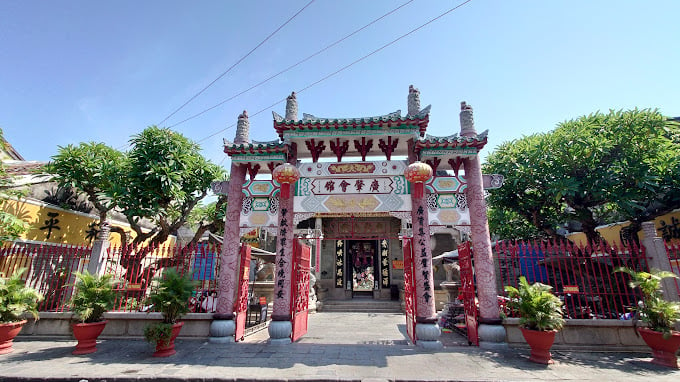
Quang Dong Assembly Hall - Precious cultural heritage
3.3 Hải Nam Assembly Hall
- Address: 10 Trần Phú Street, Hoi An, Quảng Nam Province
- Opening Hours: 7:00 AM - 5:00 PM daily
- Ticket Prices: 150,000 VND (about $6.10 USD) for foreign guests
The Hải Nam Assembly Hall was built in 1875 by the overseas Chinese community from Hải Nam. Its initial purpose was to serve as a communal gathering place and to preserve the cultural and religious values of the Hải Nam and Gia Ứng people in Hoi An.
Having withstood the test of time, the Hải Nam Assembly Hall holds great spiritual value today. It serves as a place to honor 108 Chinese merchants who were unjustly killed. This location has become a spiritual destination for visitors due to its unique architecture and serene atmosphere.
The Hải Nam Assembly Hall was constructed in the traditional "Chinese character Quốc" (國) layout, featuring several key areas such as the main hall, antechamber, and East and West wings. Upon entering, visitors will be amazed by the intricate beauty and meticulous craftsmanship of the altars, with many details carved in relief and gilded, reflecting traditional artistic values.
One particularly striking feature of the hall is the depiction of the landscapes of the three realms: Earth, Heaven, and the Underwater World. This scene is both unique and visually captivating, showcasing the cultural fusion between Eastern and Western civilizations.
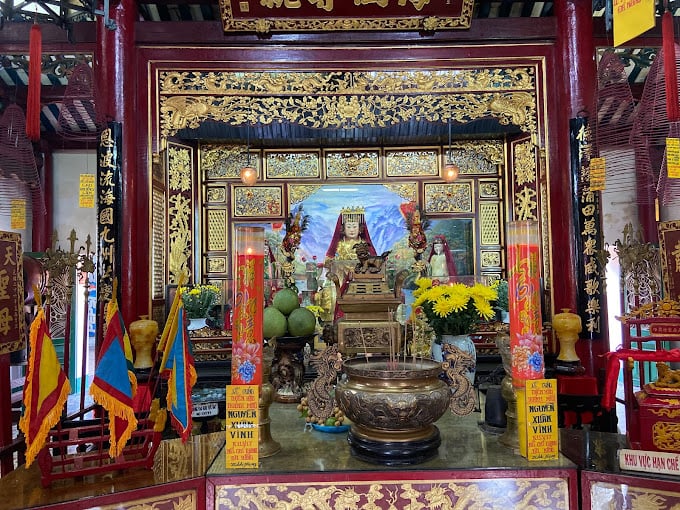
The architecture of Hải Nam Assembly Hall blends traditional and modern influences.
3.4 Chinese Assembly Hall (Ngũ Bang Assembly Hall)
- Address: 64 Trần Phú Street, Cẩm Châu, Hoi An
- Opening Hours: 7:00 AM - 5:00 PM daily
- Ticket Prices: 150,000 VND (about $6.10 USD) for foreign guests
The Chinese Assembly Hall, also known as Ngũ Bang Assembly Hall, stands as a historical symbol in the heart of the ancient town. Built in 1741, it attracts visitors with its ancient beauty and unique cultural significance.
The name "Ngũ Bang" (Five Associations) originates from the contributions of merchants from five Chinese regions: Triều Châu, Phúc Kiến, Hải Nam, Quảng Đông, and Gia Ứng. In the past, the hall served as a gathering place for Chinese merchants for cultural and spiritual activities, as well as a place to worship Guan Yu, a hero deeply respected by the Chinese community.
Despite the passage of time, the Chinese Assembly Hall has retained much of its original architecture. It strongly reflects traditional Chinese architectural features, with curved roof tiles, moss-covered stone walls, and intricate decorative details.
Inside the assembly hall are three stone steles that record the hall's history, including the times it has been restored and renamed. Notably, the hall preserves many valuable artifacts, the most remarkable being a 500-year-old iron tripod placed in the center of the courtyard. This item is not only a precious relic but also a symbol of the hall's longevity and enduring vitality.
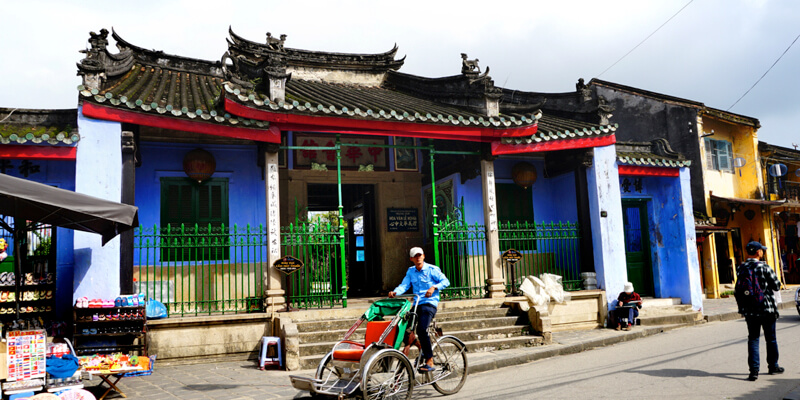
One of the indispensable Hoi An travel guide is visiting the Chinese Assembly Hall
3.5 Triều Châu Assembly Hall
- Address: 362 Nguyễn Duy Hiệu Street, Cẩm Châu, Hoi An
- Opening Hours: 7:00 AM - 5:00 PM daily
- Ticket Prices: 150,000 VND (about $6.10 USD) for foreign guests
Located on Nguyễn Duy Hiệu Street in Hoi An, the Triều Châu Assembly Hall, also known as Ong Bon Pagoda, stands tall as a spiritual symbol in the heart of the ancient town. This place is not only a sacred site that attracts visitors but also serves as a communal gathering space for the Triều Châu people in Hoi An.
Built in 1845, the original purpose of the assembly hall was to worship the sea gods, praying for safety and favorable conditions for those traveling by sea. Despite the passage of time, the Triều Châu Assembly Hall has retained its cultural value and unique architecture, making it a must-visit attraction when visiting Hoi An.
The hall showcases traditional Chinese architectural elements, with intricately carved wooden frames and decorative motifs based on ancient folklore. Additionally, it features distinctive porcelain relief works, demonstrating the skill and artistry of past craftsmen.
A particularly unique aspect of the hall is its embossed ceramic decorations. The delicate patterns, crafted in porcelain, not only enhance the building’s beauty but also reflect the locals' belief in a prosperous and fortunate life.
The Triều Châu Assembly Hall is more than just an impressive architectural structure. It also serves as a cultural and spiritual repository for the Triều Châu community in Hoi An. Religious ceremonies and rituals for good luck are regularly held here, representing the community’s faith in the sea gods and their hope for a peaceful, prosperous life.
>> See more: 40+ places to visit in Hoi An that captivates travelers
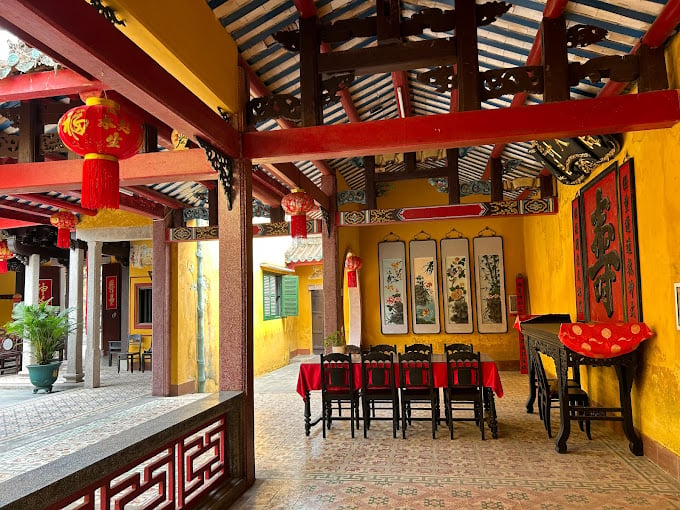
Chaozhou Assembly Hall - A place where cultural and spiritual values converge
4. Hoi An travel guide: Preserving and promoting the values of the chinese assembly halls
The Chinese assembly halls in Hoi An are not only a cultural heritage of the Chinese community but also a source of pride for the local people, attracting visitors from around the world.
Preserving and protecting these unique architectural works is the shared responsibility of every individual and group. Local residents need to raise awareness and work together to maintain the original beauty of the assembly halls. Visitors are encouraged to show respect for these cultural assets and avoid actions that could cause harm.
In addition to preservation efforts, in-depth research on the architecture, history, and culture of the Chinese assembly halls is essential. Such research forms the foundation for effective restoration and utilization of this heritage, contributing to the comprehensive and sustainable economic, cultural, and tourism development of Hoi An.
With the collective efforts of the community, the Chinese assembly halls will continue to shine, becoming must-see attractions for tourists visiting Hoi An. These places serve as a bridge for future generations to learn more about the history, culture, and traditions of this heritage-rich land.
>> See more: Tips for Hoi An travel guide saving money
5. Conclusion
The assembly halls are not only places that preserve cultural and historical values, but they are also spiritual destinations that attract visitors with their unique architecture and peaceful atmosphere. These halls contribute to the vibrant cultural mosaic of the Chinese community in Hội An, affirming the irresistible allure of this heritage site. Take time to explore these assembly halls to experience the cultural essence and learn more about the history and people of Hoi An. Undoubtedly, you will have a fascinating and memorable travel experience in this historic town, as highlighted in any comprehensive Hoi An travel guide!
-
Hotline: 1900 63 66 00
-
Press 1 For tickets
-
Press 2 For Customer Service
Latest news
![Over 30 Unique Things To Do In Hoi An Viet Nam [Monthly Update]](public/media/thumb/dao-ky-uc-hoi-an-la-mot-quan-the-du-lich-nghi-duong-van-hoa-nam-ngay-canh-pho-co1-90x90.jpg)
Over 30 Unique Things To Do In Hoi An Viet Nam [Monthly Update]

Where to Stay in Hoi An? Essential Tips for Choosing the Ideal Accommodation for First-Timers

Discover the Chinese Assembly Halls in Hoi An: Cultural Icons of the Ancient Town

Hoi An Specialties by Season: What to Eat Throughout the Year











![Over 30 Unique Things To Do In Hoi An Viet Nam [Monthly Update]](public/media/thumb/dao-ky-uc-hoi-an-la-mot-quan-the-du-lich-nghi-duong-van-hoa-nam-ngay-canh-pho-co1-358x223.jpg)


Comment